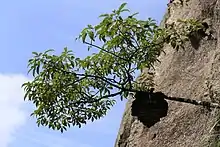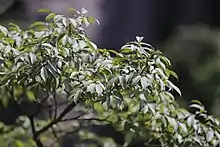| Fraxinus insularis | |
|---|---|
 | |
| Growing from a cliff. Note nameplate, which calls it retuse ash. | |
 | |
| Foliage | |
| Scientific classification | |
| Kingdom: | Plantae |
| Clade: | Tracheophytes |
| Clade: | Angiosperms |
| Clade: | Eudicots |
| Clade: | Asterids |
| Order: | Lamiales |
| Family: | Oleaceae |
| Genus: | Fraxinus |
| Species: | F. insularis |
| Binomial name | |
| Fraxinus insularis | |
| Synonyms[2] | |
| |
Fraxinus insularis, the Chinese flowering ash or island ash, is a species of flowering plant in the family Oleaceae, native to central and southeastern China, Hainan, Taiwan, the Ryukyu Islands, and Yakushima, Japan.[2][3][4] Its leaves produce a number of secoiridoid glucosides.[5]
References
- ↑ Oldfield, S. (2018). "Fraxinus insularis". IUCN Red List of Threatened Species. 2018: e.T96443992A96443994. doi:10.2305/IUCN.UK.2018-1.RLTS.T96443992A96443994.en. Retrieved 13 January 2023.
- 1 2 "Fraxinus insularis Hemsl". Plants of the World Online. Royal Botanic Gardens, Kew. Retrieved 27 September 2022.
- ↑ "Fraxinus insularis". JC Raulston Arboretum. NC State University. 2022. Retrieved 27 September 2022.
- ↑ "Fraxinus insularis". Arboretum Explorer. The Dawes Arboretum. 31 August 2022. Retrieved 27 September 2022.
This species is being evaluated for resistance to Emerald Ash Borer.
- ↑ Tanahashi, Takao; Parida; Takenaka, Yukiko; Nagakura, Naotaka; Inoue, Kenichiro; Kuwajima, Hiroshi; Chen, Chen-Chang (1998). "Four secoiridoid glucosides from Fraxinus insularis". Phytochemistry. 49 (5): 1333–1337. doi:10.1016/S0031-9422(97)00697-3.
This article is issued from Wikipedia. The text is licensed under Creative Commons - Attribution - Sharealike. Additional terms may apply for the media files.
